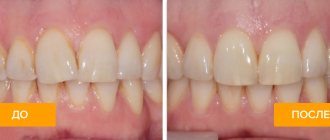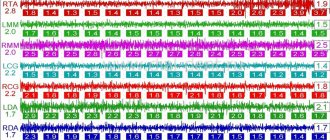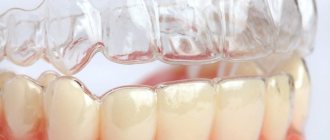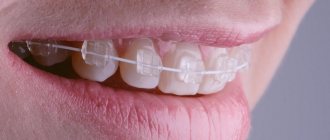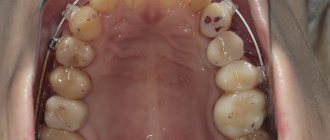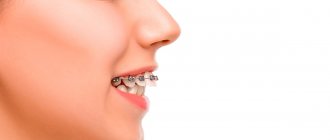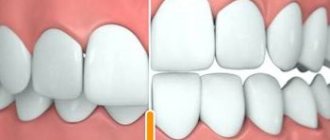An abnormal bite and crooked teeth are not only an anatomically incorrect position of the teeth on the jaw. This is the source of a whole range of problems affecting the health of a number of organs and systems that determine the psychological state of a person. Problems associated with bite are classified as chronic, which is why the patient often does not realize the severity of his condition and does not connect the existing discomfort with the condition of the oral cavity. But in vain.
How is the condition of your teeth related to your overall health?
While a person is young, his body has a significant “margin of safety”, thanks to which many problems are in a state of compensation for a long time. At the level of the oral cavity, the incorrect position of the teeth is compensated by changes in the tone of the masticatory muscles, increasing the load on the joints of the lower jaw and periodontal tissue. With age, teeth that are positioned incorrectly on the jaw begin to wear out and decay faster, increasing the likelihood of developing periodontal disease, their loosening and loss.
Insufficiently thorough chewing of food reduces the efficiency of the digestive system. Crowding and mismatch of the chewing surfaces of the antagonist teeth of the upper and lower jaws contribute to the accumulation of bacterial plaque and the rapid development of caries. Changes in the tone of the facial muscles and incorrect position of the jaws relative to each other have a negative impact on posture. Damage to the temporomandibular joint can cause chronic headaches.
Is it possible to straighten teeth without braces?
The best way to avoid wearing braces is high-quality prevention of the development of abnormal tooth growth and malocclusion.
It consists of careful oral care starting from infancy, combating bad habits that affect jaw development and timely visits to the dentist to identify and treat pathologies. If the problem could not be prevented, and the teeth have not grown as straight as we would like, it is necessary to begin correction. But is it really possible to straighten teeth without braces?
Adults and children are put off by the need to wear braces for long periods of time. But most often only these, sometimes completely invisible, devices can correct severe pathologies of tooth growth.
Fortunately, some violations can be corrected or disguised without the use of braces:
- slight displacement or twisting of teeth (no more than two in a row);
- too dense or sparse arrangement of teeth;
- uneven height of teeth;
- minor malocclusions (except open);
- chips, cracks and other defects in the integrity of the enamel.
Alternative correction methods are also offered if there are contraindications to wearing braces: early childhood, illness or mental disorders. But in these cases, you can only achieve prevention of dental deterioration, getting rid of bad habits and normalizing natural nasal breathing.
Sometimes teeth can be straightened without braces
Serious jaw pathologies can only be corrected surgically or with the help of brace systems, produced in a large assortment to suit any patient preference.
Occlusion and the psychological state of a person
The standard of beauty is perfectly straight white teeth. Depending on how close a person’s smile is to the ideal, the attractiveness of a particular individual to others is determined. You can talk as much as you like about spiritual beauty, but it is often not possible to see it behind its repulsive appearance. Crooked teeth, a significant amount of deposits, and a pronounced decrease in the height of the crowns determine not only the attractiveness, but also the age of the patient. The worse the teeth, the older the person is in the perception of other people.
An unaesthetic appearance of a smile causes difficulties in interpersonal communication, a feeling of embarrassment, awkwardness, and the formation of psychological complexes. At the same time, there is no need to constantly worry about your own imperfections. If previously it was possible to correct a bite only in childhood and adolescence, now there are no restrictions for orthodontic correction. And now there is no need to even wear braces. Aligners can be used on patients of all ages.
Complications after filing teeth
If the manipulation is carried out in a dental office under the guidance of a qualified specialist, there is a small chance of a mild complication in the form of a temporary increase in sensitivity. All reviews of teeth filing prove that the side effect goes away quickly and does not cause concern.
To avoid any complications and side effects, you should not try to file your teeth at home. Attempts to use improvised tools to correct the dentition often cause chipping of enamel particles, the appearance of cracks and damage to several teeth at the same time. Successful and high-quality sharpening of teeth is possible only with diagnostics, professional dental instruments and therapeutic agents.
Correction of bite with mouth guards
Aligners, also known as transparent aligners made of a polymer transparent biocompatible material, are made for the patient on an individual basis. They fully take into account the anatomical features of the structure of a particular dental system, which makes it possible to effectively eliminate existing disorders. The process of manufacturing aligners is quite labor-intensive, which affects the cost of the products and the time spent on orthodontic correction.
Manufacturing of aligners includes:
- complete sanitation of the oral cavity;
- taking dental impressions;
- making trays from impressions in the laboratory.
The thickness of the aligners does not exceed 1 mm. Thanks to the special properties of the materials, the aligners are not visible on the teeth even at close range, and do not cause glare in the sun or when photographing using a flash.
In what cases is grinding necessary?
As we have already said, veneers are used to correct minor defects in the dentition - for example, chipped teeth, curvature of one or two teeth, as well as diastema. The main disadvantage of this method is the grinding of dental tissue to remove all irregularities. In addition, if you do not prepare your teeth before installing veneers, then after prosthetics they will look too convex and unnatural.
The structures themselves will last about ten years, after which they must be replaced with new ones, since turning teeth is an irreversible process.
Important!
To fix the veneers, the patient’s teeth are ground down by approximately 0.3 - 0.7 mm.
Aligner capabilities
Unlike braces, the capabilities of polymer trays are somewhat limited. However, don't let this bother you. Not all patients of an orthodontist have a malocclusion so serious that they cannot do without braces. In most cases, a softer and gentler effect on the dentition is enough to improve the appearance of the smile area.
What anomalies can aligners treat:
- incorrect position of individual teeth;
- the need to perform extrusion or intrusion of teeth;
- crowding or, conversely, sparse position of teeth on the jaw;
- crossbite;
- unexpressed degree of deep bite.
Mouth guards will not cope with distal or mesial bite, since the development of these anomalies is based on the uneven development of the upper and lower jaws. In fact, this is the only limitation of the technique.
How much does it cost to straighten teeth without braces with orthodontist A. A. Arzumanov?
At an appointment with orthodontist Andranik Arkadyevich Arzumanov, the patient receives advice on possible correction of malocclusion without braces. After a complete diagnosis, at the patient’s request, teeth are straightened with aligners. The prices for the devices used are presented in the table.
Orthodontic treatment without braces - with aligners
| Name of service | Price, rub. |
| Orthodontic treatment using an aligner (up to 5 drops) | 50 000 |
| Orthodontic treatment using an aligner (up to 10 drops) | 80 000 |
| Orthodontic treatment using an aligner (up to 20 drops) | 130 000 |
By using alternative methods of teeth straightening, minor bite pathologies can be corrected or masked; however, only braces can effectively cope with severe anomalies.
Benefits of aligner treatment
Why are many people afraid of having braces? Mainly because this design creates a lot of inconvenience in everyday life. It is unaesthetic, difficult to care for, imposes significant restrictions on the choice of food products, and causes significant discomfort and pain immediately after installation and after each activation procedure.
All this is irrelevant for patients with aligners. The mouth guards can be removed for cleansing, eating, or attending a significant event. They do not affect diction, which is very important for people who often speak in public. You can take pictures with them, smiling “with all 32 teeth,” communicate, kiss. In general, live a normal life and not feel any restrictions.
In addition, aligners have other strengths:
- the material from which the mouthguards are made does not absorb pigments from food and drinks, and therefore does not darken over time;
- biosilicone is a hypoallergenic material, so it can be used without the risk of complications even in people with polyvalent allergies;
- uniform distribution of pressure over the entire surface of the dental crown provides a softer and more gentle effect on periodontal tissue;
- the absence of discomfort and restrictions contributes to maintaining high motivation and adherence to treatment on the part of the patient until the very end of the correction course;
- the final result of the correction is known in advance, since all stages of treatment are planned using a special computer program.
Fourth method. Trainers who fight bad habits
How else can you fix crooked teeth without braces? The orthodontist may suggest that you wear trainers. We agree, these devices look massive and completely unattractive. However, they not only correct the bite, but also eliminate the main causes of its appearance, namely, bad functional habits: incorrect type of breathing, incorrect position of the tongue. These devices train the jaw muscles and teach them to work correctly. Another plus is that they are removable, which means you can remove them from your mouth during meals and oral hygiene. They should be worn mainly at night.
Trainers are mainly worn at night
As a rule, trainers are prescribed to children, but they are also recommended for adults with pathologies of mild to moderate severity.
Doctors offer patients to correct crooked teeth without braces using Myobrace trainers, which are produced by the Australian company MRC. These trainers are leaders in their industry.
Surgical bite correction
Another way to correct the position of teeth in the jaw is to perform orthognathic surgery, during which the size and position of the jaws are changed. The operation is preceded by a period of wearing braces. The orthodontic structure will have to be worn for a certain time even after the intervention.
Surgery is indicated for patients only in extreme cases when braces as an independent method of correction cannot correct the patient’s anomaly. The intervention is performed in a hospital setting as planned after a period of preliminary preparation. You will have to spend several weeks in a hospital bed, since the recovery period is quite difficult and the patient requires constant medical supervision.
Indications
There are opposing opinions among dentists regarding the procedure, but there are situations in which filing is necessary:
- When installing crowns. For reliable fixation of the crown, it must fit tightly to the tooth surface.
Since the anatomical shape of each molar or incisor is not ideal, grinding down of the upper layers of their hard tissue is required. This allows you to give your own bone organ the correct geometric shape, thanks to which the manufactured product is firmly fixed and does not stand out among other elements of the jaw row. - For fixing veneers. Ceramic plates fixed to the surface of your own teeth have a certain thickness.
Therefore, in order for the installed microprostheses to fit firmly and not protrude beyond the boundaries of the native units, a small amount of hard tissue is ground off from the vestibular side of the elements of the jaw row. - Preparation for inlays. If it is necessary to mask the cavity formed as a result of carious lesions, ceramic or metal inlays can be used.
Their fixation requires the creation of side walls and the formation of the required depth near the cavity. - In case of installation of an orthodontic structure. Cutting down a small thickness of the top layer of the tooth allows you to make room for correcting the position of the remaining elements of the row without the need to remove them.
In addition, this option is often used in cases of increased crowding of teeth, since it facilitates the placement of fastening elements of the bracket system on them. - If there is damage to the enamel. Chips on the surface of the front incisors can be made less noticeable by slightly filing down the enamel.
This improves the aesthetics of the appearance of the jaw row and eliminates the need for composite restoration. - In case of elongated incisors. If the front teeth are longer than the rest of the row, this can not only cause psychological discomfort, but also interfere with correct diction or complete chewing of food.
To solve the problem, in some cases, filing the length of organs protruding from the common line is used. - At sharp angles. The anatomical structure of the anterior incisors is not always ideal. If there are sharp corners, dentists may recommend filing them down, which will increase the aesthetic appearance of the entire jaw row.
Indications for the use of orthoimplants and tactics for their installation.
Let's discuss here how the braces system works.
At this address https://orto-info.ru/ortodonticheskoe-lechenie/podgotovitelnyiy-period/separatsiya-zubov.html we will talk about abrasive teeth separation.
Artistic restoration of teeth
If there is no time or opportunity to fix a defect, it can be disguised. It is not advisable to put on braces or spend money on a set of aligners for the sake of 1-2 crooked teeth. You can change the appearance of dental crowns using composite materials. In this way, you can remove scars and diastemas, visually lengthen your teeth, and correct the cutting edges of your teeth.
Artistic restoration can also be used after treatment with orthodontic structures in order to bring the result to perfection, cover areas of enamel damage when removing locks, and disguise other defects.
As you can see, braces are not the only way to achieve a perfect smile. They are not suitable for everyone and not everyone needs them. To choose the most effective way to eliminate defects in the dentition, you can contact an orthodontist and listen to his opinion.
Is it possible to straighten teeth in adults?
Of course, treatment is faster in children and adolescents. This is due to the fact that up to the age of 25 in a person, the processes of bone tissue regeneration proceed faster, the ossification of bone sutures has not yet been completed, which means orthodontic treatment will be more effective. But don’t think that adults can’t be helped. Dentists have been successfully helping straighten teeth for patients of any age for a long time. It just takes a lot of time. Orthodontists typically recommend braces or aligners as options for straightening teeth in adults. In some cases, if only one or two teeth are misaligned, doctors may use veneers. These extremely thin dental coverings provide a quick solution to the problem of an imperfect smile. If the problem is several teeth and in addition the doctor diagnoses malocclusions, you will still have to use orthodontic structures.
Increased sensitivity after the procedure
Many patients who have had their teeth filed complain of increased sensitivity, especially when eating hot and cold dishes and hard foods.
Dentists explain this phenomenon as follows. Dentin, located under the enamel, is penetrated by many tubules, inside of which nerve endings are located. As the thickness of the enamel decreases, pressure changes occur, which can cause pain when taking certain foods.
To reduce tooth sensitivity after the procedure, dentists recommend temporarily avoiding too hard foods, dishes with high and low temperatures, and acidic drinks.
During oral hygiene, you should use a brush with soft bristles and therapeutic and prophylactic toothpaste, rinses for sensitive teeth.
If sensitivity does not disappear a week after filing, you should contact your dentist.
Indications and contraindications for orthognathic surgery, recovery time.
In this article we will tell you how to install braces on crowns.
Follow the link https://orto-info.ru/ortodonticheskoe-lechenie/podgotovitelnyiy-period/informativnost-telerentgenogrammyi.html if you are interested in the importance of a teleroentgenogram in orthodontics.
Price
The cost of filing teeth depends on the reasons for which it is carried out and what result is needed to achieve:
- preparation for caries - from 200 to 350 rubles per row element;
- treatment of enamel after removing braces – 550-650 rubles;
- identification of traumatic occlusion and grinding of one tooth – 200-300 rubles;
- cutting down a tooth for a crown – 130-200 rubles;
- filing a molar under an orthodontic structure – 150-200 rubles.
Find out how teeth are prepared in the video.
Corrective exercises – myotherapy
As a rule, myotherapy is an addition to the correction of occlusion using various orthodontic devices or as the main method in the treatment of children from 4 to 8 years old. Physical exercises help develop and strengthen facial muscles, stimulate bone growth, and have a positive effect on trophic processes.
Let's look at some effective exercises:
- to correct a deep bite: stand straight with your chin raised as much as possible. Move the lower jaw forward, then return to its original position. Repeat 15 – 17 times;
- to correct open occlusion: take a pencil (you can put a rubber tube on it), squeeze it with your teeth with adequate force. Perform for 4 – 5 minutes;
- with a crossbite: open your mouth as wide as possible, move your jaw towards the defect, close your jaws in the correct position for 5 seconds, then relax, then repeat the exercise again;
- to correct mesial occlusion: use your tongue to press on the inside of the front part of the upper dentition. Perform the exercise for 5 minutes.
Important: when performing any exercises of the myogymnastics complex there should be no pain. After each approach, you need to let the muscles relax for 1 minute.
Contraindications
The necessity and admissibility of filing teeth is determined by the dentist individually in each case, since the procedure is quite labor-intensive and can be traumatic in some situations.
For this reason, sewing hard fabric is contraindicated in the following situations:
- increased abrasion of enamel;
- hyperesthesia;
- bruxism;
- presence of bad habits - frequent chewing of seeds and nuts, opening bottles with teeth;
- high risk of injury to the incisors, for example, boxing and other types of wrestling.


